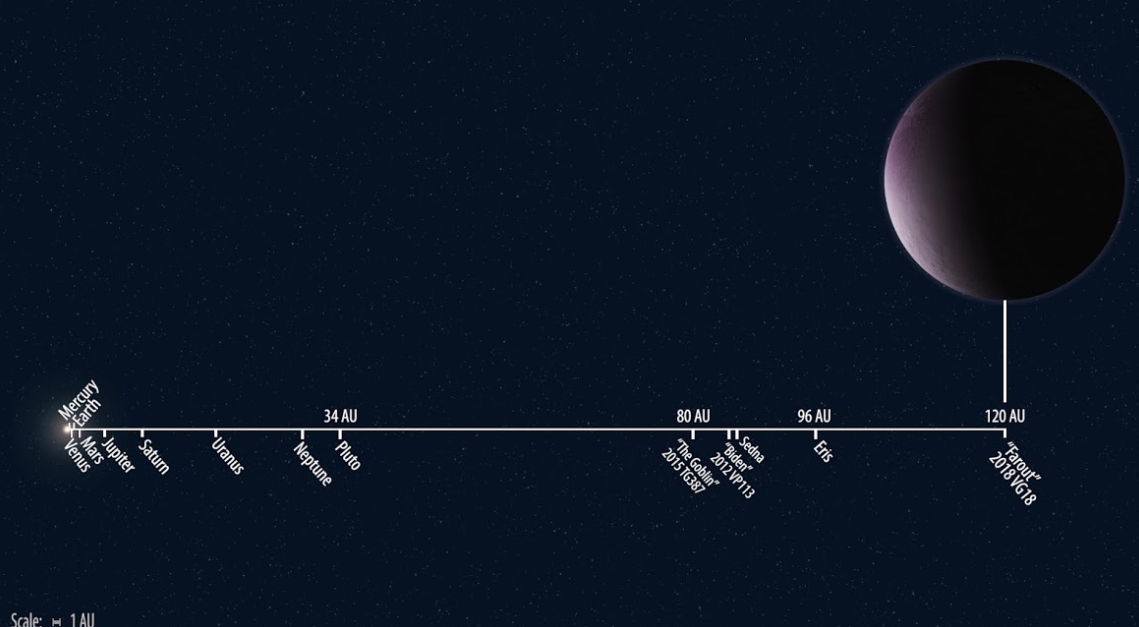The boundaries of astronomical discovery keep getting pushed, especially in the 21st century with new technologies and equipment being put on line at a rapid pace. On December 17, 2018, 115 years to the day after the Wright Brothers made their first flight, astronomers at the Carnegie Institution for Science and the International Astronomical Union’s Minor Planet Center announced the discovery of possible dwarf planet 2018 VG18, the farthest known world to be discovered in the solar system to date.
2018 VG18, also nicknamed “Farout” due to its great distance from the Sun, is a world big enough to be round and therefore to be categorized as a dwarf planet along the lines of Pluto, Ceres, Eris, Haumea, and other small worlds that have not cleared their orbits.
Farout, the first world to be discovered at a distance of over 100 AU, was discovered last month by a team led by Scott S. Sheppard from Carnegie University, Chad Trujillo of Northern Arizona University, and David Tholen from the University of Hawaii.

Farout moves between the two discovery images while the background stars and galaxies do not move over the 1 hour between images. Credit: Scott S. Sheppard/David Tholen.
This team, working to try to find the theorized “Planet 9” in the outer reaches of the Solar System, has discovered other small worlds like 2015 TG387 “the Goblin” using the 8-meter (26 foot) Subaru telescope at Mauna Kea, Hawaii. The team used the Subaru telescope to discover 2018 VG18 as well, and the discovery image was taken on November 10th of this year. Earlier this month the Magellan telescope at Las Campanas Observatory in Chile made follow up observations of the object to determine its brightness, color, and orbital path.
2018 VG18 was discovered at approximately 120 AU (astronomical units) from the Sun. This is slightly farther than the distance that Voyager 2 is now out from the Sun after crossing the heliopause (where the solar atmosphere is pushed back by the interstellar medium) into interstellar space. For comparison, Earth is at 1 AU from the Sun and Voyager 1, which penetrated the heliopause in 2012, is at 144 AU right now, while Ultima Thule, where New Horizons will fly past on New Year’s Day, is at 43 AU.
This world was discovered at a further distance than 2015 TG387 (discovered at 80 AU) but 2018 VG18’s orbital parameters (for example, its perihelion and aphelion) are not well constrained and many follow up observations over the next several years are needed. (For comparison 2015 TG387’s orbit was studied over three years). It is believed that one year on Farout is a millennium in Earth years, approximately 1000 Earth-years to orbit the Sun, compared to 40,000 Earth years for 2015 TG387.
Farout is approximately 500 kilometers (310 miles) in diameter, which is somewhat larger than “the Goblin” at 300 kilometers (186 miles) in diameter, and Farout is pinkish in color, indicating large quantities of ice. This is the limit of what we know about this world right now, and it would take decades for any probe sent with current technology to reach this world.

2018 VG18 “Farout” compared to other known Solar System objects. Credit: Roberto Molar Candanosa/Scott S. Sheppard/Carnegie Institution for Science.
At this moment, since Farout’s orbital parameters are not well constrained, it is unknown whether this world’s orbit supports the theorized “Planet 9” or points to its existence or location. However, Scott Sheppard observed that Farout was found in a similar part of the sky as other recent finds like the Goblin and 2012 VP113 “Biden” (at 84 AU).
These worlds don’t come close enough to the known planets of the Solar System to be strongly influenced by them, so they can possibly point to worlds like “Planet 9”, and if Farout shows a similar orbit, it can help confirm that the theorized clustering of small worlds pointing to Planet 9’s existence is not random.
The exploration of the outer Solar System beyond the known planets has really just begun. New technology such as wide-field digital cameras mounted to the new generation of larger telescopes as well as ongoing missions like the Voyager Interstellar Mission and New Horizons are quickly transforming our knowledge of the outer reaches of the Solar System bordering interstellar space.
